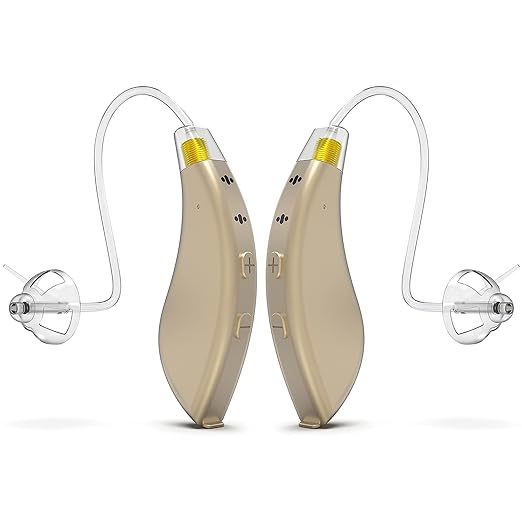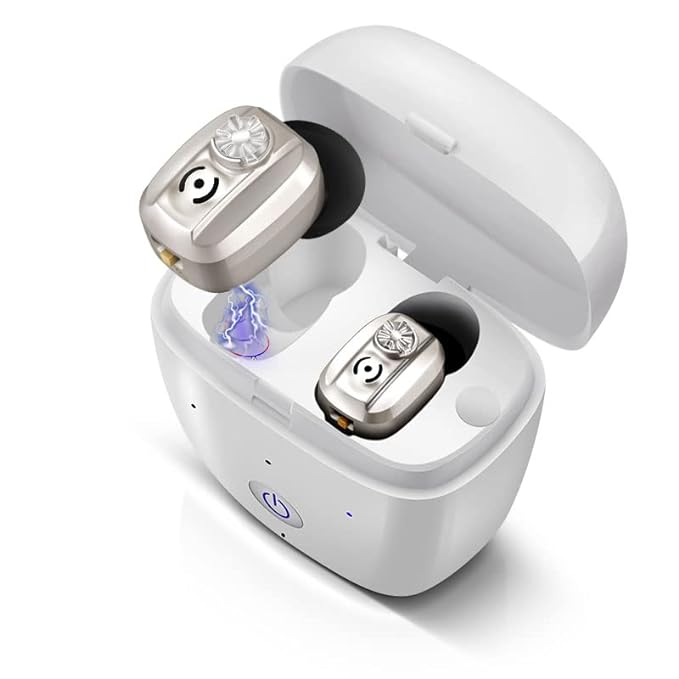What is Hearing Aid?
Hearing aids are small electronic devices designed to amplify sound for individuals with hearing loss. They consist of a microphone to pick up sound, an amplifier to increase the volume of the sound, a receiver to deliver the amplified sound to the ear, and a power source such as batteries. When someone with hearing loss wears a hearing aid, it collects sounds from the environment through the microphone, processes these sounds using advanced digital signal processing technology, amplifies them to an appropriate level based on the individual’s hearing loss profile, and delivers the amplified sounds to the ear through a speaker or receiver.

BlaidsX Pro Programmable Hearing Aids for Adults with Mobile App Hearing Test & Noise Cancellation, Hearing Aids for Seniors with Bluetooth, Dual Mic & 48 DSP Channels (Both Ears, Beige)
₹48,000 ₹64,000
Types of Hearing Aids:
Behind-the-Ear (BTE):
Components: The main part rests behind the ear and is connected to an earmold or dome that fits inside the ear canal.
Benefits: Suitable for various degrees of hearing loss, easy to handle and clean, can accommodate larger batteries for longer battery life, often have more advanced features.

Britzgo Rechargeable Hearing Aids Amplifier with Noise Reduction for Seniors, Cancellation,Up to 20hrs Battery Life (Silver)
₹8,999
Receiver-in-Canal (RIC) or Receiver-in-the-Ear (RITE):
Components: Similar to BTE but with the receiver (speaker) placed in the ear canal, connected to the main body by a thin wire or tube.
Benefits: Less visible than traditional BTE, provides natural sound quality, comfortable fit, suitable for mild to severe hearing loss.
In-the-Ear (ITE):
Components: Entirely housed in a custom-made shell that fits in the outer ear.
Benefits: Less visible than BTE or RIC, easy to handle, suitable for mild to severe hearing loss depending on the size of the device.
In-the-Canal (ITC):
Components: Smaller than ITE, fits partially in the ear canal.
Benefits: Less visible than ITE, comfortable fit, suitable for mild to moderate hearing loss.
Completely-in-the-Canal (CIC):
Components: Smallest type, fits entirely inside the ear canal.
Benefits: Virtually invisible, provides natural sound quality, less susceptible to wind noise, suitable for mild to moderate hearing loss.
Invisible-in-Canal (IIC):
Components: Placed deeper in the ear canal than CIC, almost invisible.
Benefits: Extremely discreet, comfortable, suitable for mild to moderate hearing loss.
Extended Wear Hearing Aids:
Components: These are typically soft, silicone-based devices worn deep in the ear canal for several months at a time.
Benefits: No daily insertion or removal required, comfortable for wearing while sleeping or exercising, suitable for mild to moderate hearing loss.
Each type of hearing aid has its advantages and limitations, and the best choice depends on factors such as the degree of hearing loss, lifestyle, preferences, and budget. It’s essential to consult with an audiologist to determine the most suitable option for your specific needs.
Choosing the right hearing aids can significantly improve your quality of life. Here’s a guide to help you through the process:
Get a Hearing Test: Before anything else, have your hearing tested by an audiologist. This will determine the extent of your hearing loss and guide you in selecting the appropriate hearing aids.
Consider Your Lifestyle: Think about your daily activities and environments. Do you spend a lot of time in noisy places? Are you frequently on the phone? Do you enjoy outdoor activities? These factors will influence the type of hearing aids that will best suit your needs.
Types of Hearing Aids:
Behind-the-ear (BTE): These sit behind the ear and are suitable for various degrees of hearing loss.
In-the-ear (ITE): These fit entirely in the outer ear and are less visible but may not be suitable for severe hearing loss.
In-the-canal (ITC) and Completely-in-the-canal (CIC): These are smaller and less visible than ITE aids but may not have features like directional microphones.
Features:
Directional Microphones: These help focus on sounds in front of you, beneficial in noisy environments.
Telecoils: Allow you to hear better on the phone or in public venues with loop systems.
Noise Reduction: Reduces background noise for clearer sound.
Bluetooth Connectivity: Enables connectivity with smartphones, TVs, and other devices for direct streaming of audio.
Size and Comfort: Consider the size and comfort of the hearing aids, especially if you wear them for extended periods. Smaller devices may be less noticeable but might have fewer features or shorter battery life.
Trial Period: Many providers offer a trial period for hearing aids. Take advantage of this to ensure the devices meet your needs in various situations.
Cost and Insurance: Hearing aids can be expensive, and not all insurance plans cover them. Research your options and consider financing or payment plans if needed.
Follow-up Care: Ensure the provider offers ongoing support and adjustments as needed. Regular maintenance and follow-up appointments are essential for optimal performance.
User Reviews and Recommendations: Look for reviews and seek recommendations from friends, family, or online communities who have experience with hearing aids.
Take Your Time: Choosing the right hearing aids is a significant decision. Don’t rush the process; take your time to explore your options and find the devices that best suit your needs and lifestyle.
Modern hearing aids come with various features and technologies to improve sound quality and enhance the listening experience. These may include noise reduction, directional microphones to focus on speech in noisy environments, feedback cancellation to reduce whistling or buzzing sounds, and connectivity options such as Bluetooth for streaming audio directly from smartphones, TVs, and other devices.
Choosing the right hearing aid involves considering factors such as the type and severity of hearing loss, lifestyle, personal preferences, and budget. It’s essential to work closely with an audiologist who can conduct a comprehensive hearing evaluation, provide guidance on selecting the most suitable hearing aid, and offer ongoing support and adjustments to ensure optimal performance and user satisfaction.

